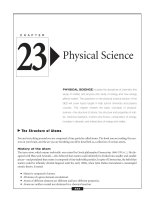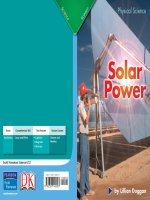physical science solar power
Bạn đang xem bản rút gọn của tài liệu. Xem và tải ngay bản đầy đủ của tài liệu tại đây (6.02 MB, 14 trang )
Scott Foresman Science 6.12
Genre Comprehension Skill Text Features Science Content
Nonfi ction Cause and Effect • Captions
• Diagrams
• Glossary
Climate and
Weather
ISBN 0-328-14005-8
ì<(sk$m)=beaafd< +^-Ä-U-Ä-U
14005_01-04_CVR_FSD.indd Cover114005_01-04_CVR_FSD.indd Cover1 5/25/2005 4:40:47 PM5/25/2005 4:40:47 PM
Scott Foresman Science 6.12
Genre Comprehension Skill Text Features Science Content
Nonfi ction Cause and Effect • Captions
• Diagrams
• Glossary
Climate and
Weather
ISBN 0-328-14005-8
ì<(sk$m)=beaafd< +^-Ä-U-Ä-U
14005_01-04_CVR_FSD.indd Cover114005_01-04_CVR_FSD.indd Cover1 5/25/2005 4:40:47 PM5/25/2005 4:40:47 PM
1. How does sunlight help plants to make food?
2. What are the benefi ts of solar energy compared
with fossil fuels?
3. Why does the International Space Station need
solar cells?
4.
Flatbed solar panels and
photovoltaic cells both harness energy from the
Sun, but in different ways. Write to explain the
differences in how these two types of panels
work. Include details from the book to support
your answer.
5 .
Cause and Effect How is energy produced in
fusion reactions in the Sun’s core?
What did you learn?
Extended Vocabulary
alternative energy sources
fusion
heliostats
photon
photovoltaic
semiconductor
solar cell
solar collector
solar energy
Vocabulary
air mass
air pressure
atmosphere
climate
front
humidity
meteorologist
relative humidity
weather
Picture Credits
Every effort has been made to secure permission and provide appropriate credit for photographic material.
The publisher deeply regrets any omission and pledges to correct errors called to its attention in subsequent editions.
Photo locators denoted as follows: Top (T), Center (C), Bottom (B), Left (L), Right (R), Background (Bkgd).
Opener: Lester Lefkowitz/Corbis; 1 Getty Images; 2 Tony Craddock/Alamy Images; 4 Getty Images; 10 Otto Rogge/
Corbis; 12 David R. Frazier Photolibrary, Inc./Alamy Images; 14 Mike Southern/Eye Ubiquitous/Corbis; 15 Joe Sohm/
Alamy Images; 17 ©Kevin Burke/Getty Images;18 Reuters/Corbis; 19 (T) Stringer/David Mariuz/Reuters/Corbis;
20 NASA; 21 (T) NASA; 22 Lester Lefkowitz/Corbis.
Scott Foresman/Dorling Kindersley would also like to thank: 19 (TR) Phil Farrand/DK Images.
Unless otherwise acknowledged, all photographs are the copyright © of Dorling Kindersley, a division of Pearson.
ISBN: 0-328-14005-8
Copyright © Pearson Education, Inc. All Rights Reserved. Printed in the United States of America.
This publication is protected by Copyright, and permission should be obtained from the publisher prior to any
prohibited reproduction, storage in a retrieval system, or transmission in any form by any means, electronic,
mechanical, photocopying, recording, or likewise. For information regarding permission(s), write to
Permissions Department, Scott Foresman, 1900 East Lake Avenue, Glenview, Illinois 60025.
3 4 5 6 7 8 9 10 V010 13 12 11 10 09 08 07 06 05
14005_01-04_CVR_FSD.indd Cover214005_01-04_CVR_FSD.indd Cover2 5/25/2005 4:41:06 PM5/25/2005 4:41:06 PM
by Lillian Duggan
14005_05-28_FSD.indd 114005_05-28_FSD.indd 1 5/25/2005 4:41:49 PM5/25/2005 4:41:49 PM
2
What You Already Know
Many factors infl uence Earth’s weather and climate.
Weather is the condition of the atmosphere at a particular
moment. Climate is the pattern of weather that occurs in an
area over a long period of time.
The blanket of gas that surrounds a planet is its atmosphere.
Earth’s atmosphere is composed mainly of nitrogen and oxygen.
The particles that make up the gases in the air are constantly
bumping into other matter. The measure of force with which air
particles push on matter is air pressure. The different layers of
the atmosphere vary in air pressure and temperature.
Differences in air pressure between different areas cause
wind. Winds move from areas of high pressure to areas of
low pressure.
Water vapor in the air can make it feel damp. Humidity
is the amount of water vapor in the air. The amount of water
vapor that air can hold depends on its temperature. Relative
humidity is the amount of water vapor the air contains
compared with the amount it could hold at that temperature.
14005_05-28_FSD.indd 214005_05-28_FSD.indd 2 5/25/2005 4:42:04 PM5/25/2005 4:42:04 PM
3
Clouds are made up of millions of tiny water droplets that
form around small particles in the air. When the water droplets
become large enough, precipitation falls from the clouds as rain,
snow, sleet, or hail.
Usually precipitation is mild or moderate, but it can also be
part of a severe storm. Everyone should know what precautions
to take in case of a thunderstorm, tornado, or hurricane.
You may hear your local weather forecaster talk about air
masses and fronts. An air mass is a very large body of air that has
a similar temperature and humidity throughout. The boundary
that forms between air masses is called a front. Weather at a front
is often cloudy or stormy. Meteorologists are scientists who study
weather. They predict the weather by monitoring the movements
of air masses. Although weather can change quickly, the climate
of a particular area is usually stable.
Many different factors contribute to the weather. The primary
force behind weather, though, is the Sun. In this book, we’ll learn
how the Sun produces the energy that sustains life, and how we
can use its power.
14005_05-28_FSD.indd 314005_05-28_FSD.indd 3 5/25/2005 4:42:12 PM5/25/2005 4:42:12 PM
4
Energy for Life
Living things on Earth need energy to move and grow.
Fortunately, the planet has a tremendous energy source. The Sun
is about 93 million miles away from Earth, but it supplies all
living things with the energy needed for life.
Plants use sunlight to make their own food. This process is
called photosynthesis. In photosynthesis, a chemical reaction
between carbon dioxide and water creates glucose and oxygen.
Plants use glucose, a type of sugar, for food.
Most plants contain a substance called chlorophyll, which
absorbs sunlight. The sunlight provides energy that is necessary
for photosynthesis to take place.
Sunlight stored in these crops will
later be transferred to humans.
14005_05-28_FSD.indd 414005_05-28_FSD.indd 4 5/25/2005 4:42:16 PM5/25/2005 4:42:16 PM
5
Animals also rely on the Sun for their energy. Some
animals eat plants, which contain stored energy from the Sun.
This energy is transferred to the animal. Other animals eat the
animals that eat plants. The Sun’s energy is then transferred
to these animals.
Energy from wood, coal, natural gas, and petroleum is also
made indirectly by the Sun. Trees store the Sun’s energy in their
woody tissue. When the “wood” is burned, the energy is released
as heat and light.
Coal, natural gas, and petroleum are all fossil fuels. Fossil
fuels were formed over millions of years from plant and animal
remains. The Sun’s energy was stored in plants and animals.
When they died, their remains became buried. Over millions of
years, layers of rock pressed down on the remains until they
became fossil fuels. Burning these fuels releases the stored energy
of the ancient sunlight.
Energy from the Sun even powers the weather. The Sun
evaporates water to make clouds which cause rain. It also heats air,
causing it to move as wind.
The Sun also keeps the oceans warm and prevents them from
freezing. If the oceans were to freeze, the land would be too cold
for living things to survive.
water
glucose
carbon dioxide
oxygen
light
In photosynthesis, carbon dioxide
and water combine in the presence of
sunlight to make glucose and oxygen.
14005_05-28_FSD.indd 514005_05-28_FSD.indd 5 5/25/2005 4:42:28 PM5/25/2005 4:42:28 PM
Inside the Sun
In less than one hour, enough energy from the Sun reaches
Earth to meet the demands of the entire world for one year.
How does the Sun produce so much energy? Let’s take a look
inside the Sun to fi nd out.
The Sun is made up of different parts. Deep inside the
Sun is the core. The core is the hottest part of the Sun, with
a temperature of about 15 million degrees Celsius. A nuclear
reaction known as fusion takes place in the core. In a fusion
reaction, atoms combine and large amounts of energy are
released. These reactions are possible only under great heat
and pressure.
Energy made by fusion reactions in the
Sun’s core travels to the photosphere.
photosphere (Sun’s
visible surface)
Nuclear reactions in the
core release energy.
6
14005_05-28_FSD.indd 614005_05-28_FSD.indd 6 5/25/2005 4:42:34 PM5/25/2005 4:42:34 PM
Sun to Earth
The energy produced in the Sun’s core takes at least thirty
thousand years to travel to the Sun’s surface. However, this
energy takes only 8.3 minutes to reach Earth. Photons follow
a random path through the Sun and a straight path to Earth.
The two gases that make up most of the Sun are hydrogen
and helium. In the core, hydrogen atoms combine to form helium
atoms through fusion reactions. Some of the hydrogen does not
get converted into helium. This leftover hydrogen is converted
directly into energy.
This energy eventually travels to the Sun’s surface in the form
of photons. A photon is a particle of light energy. A photon’s trip
from the core to the surface takes at least thirty thousand years.
Along the way the photon encounters many hydrogen atoms,
which continuously absorb and release it. When it fi nally reaches
the surface and open space, the photon travels quickly, taking a
mere 8.3 minutes to reach Earth.
Photons may have to travel 93 million miles to reach Earth,
but they still have tremendous power when they get here. One
painful reminder of this power is sunburn. Sunburn happens
when skin is overexposed to the Sun. Solar power is usually
benefi cial to people and Earth, though. We’ll now look at some
ways we can put this power to use.
Energy from the
Sun reaches Earth
in 8.3 minutes.
Photons take
a random path
inside the Sun.
the Sun
7
14005_05-28_FSD.indd 714005_05-28_FSD.indd 7 5/25/2005 4:42:46 PM5/25/2005 4:42:46 PM
8
Collecting Sunlight
Some people use the Sun as a direct source of energy.
Prehistoric cave dwellers, for example, chose caves that faced the
Sun so they could take advantage of the Sun’s energy to keep
their caves warm.
Today our energy needs are much different than they were
thousands of years ago. We use energy to run our cars, light and
heat our homes and schools, cook our food, power our factories,
and even dry our hair. Nearly everything we do requires energy.
For about two hundred years, fossil fuels have been our
primary source of energy. However, the supply of fossil fuels is
limited. Once they are used up, fossil fuels cannot be replaced.
Also, the burning of fossil fuels for energy is damaging to the
environment. Most scientists believe it causes environmental
hazards, such as acid rain and global warming.
This library in Canada
uses glass walls to
take advantage of
the Sun’s energy.
14005_05-28_FSD.indd 814005_05-28_FSD.indd 8 5/25/2005 4:42:53 PM5/25/2005 4:42:53 PM
9
As people around the world have become more and more
concerned about our use of fossil fuels, they have worked to
develop alternative energy sources. Alternative energy sources
are other ways of producing energy besides burning fossil fuels.
Alternative energy sources are generally renewable, meaning they
can be used over and over. Wind, water, and solar energy are
alternative energy sources that are clean and renewable. Solar
energy is energy produced by the Sun.
Scientists have developed many complex ways to harness the
energy of the Sun. However, collecting solar energy can be quite
simple. For example, many towers and buildings are purposely
built with exterior glass walls. These walls absorb the heat
generated by solar energy, which helps save on heating costs.
They also provide light for people inside.
A variety of devices called solar collectors have been
developed to capture solar energy. Solar collectors would not
work without materials that refl ect and absorb sunlight. When
the Sun’s rays shine on an object, the object either absorbs the
rays or refl ects them. Objects with dark and dull surfaces absorb
solar energy, becoming warm. Objects that are shiny and
light-colored refl ect solar energy away from them, staying cool.
Aluminum foil is a readily available refl ective material.
You can use aluminum foil to make a solar collector similar to
the one above. Such collectors can be used to cook food.
This simple solar collector is just
a disk covered with aluminum
foil. It focuses the Sun’s energy
to toast bread.
14005_05-28_FSD.indd 914005_05-28_FSD.indd 9 5/25/2005 4:43:03 PM5/25/2005 4:43:03 PM
10
The most common solar collectors are fl atbed collector
panels. These panels consist of a metal box with a glass or plastic
cover. Inside the box is a dark absorber plate, a refl ective surface,
and pipes carrying water or air. The absorber plate collects solar
energy, and the refl ector transfers the energy to the pipes, which
heats the water or air inside. The water or air travels through the
pipes to a storage tank. Flatbed collector panels are often
mounted on roofs and used to heat homes and other buildings
or to heat water.
Concentrating solar collectors collect the Sun’s energy over
a broad surface and refl ect it onto a small area. These collectors
reach much higher temperatures than fl atbed collectors and may
be curved or fl at.
Concentrating collectors are sometimes used in large groups
to provide energy to run power plants. At central receiving
stations, hundreds or thousands of fl at collectors transmit solar
energy to a single tower, called a solar power tower. The tower is
located in the center of the fi eld of collectors.
absorber plate
transparent
plastic fi lm
pipes
In this fl atbed solar collector
panel, the foil refl ects solar
energy toward the pipes.
14005_05-28_FSD.indd 1014005_05-28_FSD.indd 10 5/25/2005 4:43:10 PM5/25/2005 4:43:10 PM
11
Trough collectors are the best at concentrating the power of
the Sun. Shaped like curved rectangles, trough collectors can
concentrate solar energy at thirty to one hundred times its normal
intensity. The mirrored surface refl ects energy to a pipe that runs
along the middle of the trough. The energy heats oil running
inside the pipe. The heated oil generates steam that drives an
electric generator.
Bowl-shaped concentrating collectors are called solar dishes.
The dishes are covered with refl ective material. The material
refl ects sunlight onto a tube in the center of the dish, heating up
water in the tube.
Solar trough collectors in
California produce 99 percent
of the solar-generated electric
power in the United States.
14005_05-28_FSD.indd 1114005_05-28_FSD.indd 11 5/25/2005 4:43:19 PM5/25/2005 4:43:19 PM
12
Electricity from Sunlight
Some of the concentrating collectors you read about use
the Sun’s energy to drive power plants that generate electricity.
However, solar energy also can be changed directly into electricity
by solar cells. Solar cells are also called photovoltaic cells.
Most solar cells are made of silicon, an element found in
Earth’s crust. Sand on the beach is made up mostly of silicon.
Silicon is useful in the development of electronics because it can
be made into a semiconductor. A semiconductor has the ability
to conduct electricity, but in a controlled way. Semiconductors
are used in all sorts of electronic devices, from transistor radios
to computers.
Solar cells contain two layers of silicon semiconductors.
When photons of light fall upon the silicon, the silicon absorbs
some of the photons. When enough solar energy is absorbed,
electrons are freed from the silicon. Electrical charges begin
to move between the
two layers of silicon,
producing an
electric current.
A solar calculator uses a solar
cell to generate power.
14005_05-28_FSD.indd 1214005_05-28_FSD.indd 12 5/25/2005 4:43:31 PM5/25/2005 4:43:31 PM
13
A calculator’s solar cell is attached
to a multimeter, which measures
in volts the electric current
generated by the cell.
Solar Panels
Photovoltaic solar panels are
made up of many solar cells.
The cells are connected to one
another, so all the current
generated by all the cells is
combined. Some solar panels
can produce about one hundred
watts of electricity per square
meter, compared to one or
two watts for a single cell.
Solar cells are used to power
many devices, including some
common, everyday objects. Perhaps
you use a solar-powered calculator
to do your homework, or you may
have a solar-powered watch. More
complicated photovoltaic systems
generate electricity for homes and
communications equipment. Some
parking meters and streetlights are powered by solar cells.
A single solar cell is usually less than ten centimeters wide,
and generates only about one or two watts of electricity. Because
this is not enough power to run most electronic devices, multiple
solar cells can be placed onto solar panels. The solar cells are
connected on the panels, and their electricity output is combined.
solar panel
enlarged view
of solar cell
solar cells
Multimeter
measures voltage.
circuitry
14005_05-28_FSD.indd 1314005_05-28_FSD.indd 13 5/25/2005 4:43:40 PM5/25/2005 4:43:40 PM
14
Panels of solar cells are invaluable as power sources in
remote areas, where power lines can’t reach. The cells are
portable and can be used wherever there is sunlight. High in the
Himalaya mountains, far from any power lines, Tibetan villages
rely on solar panels to provide electricity. Other places may use
solar panels to generate electricity to pump water from wells.
Scientists working in isolated places often take portable
panels with them to power their equipment. Doctors who travel
from village to village in places without electricity use solar
panels to run small refrigerators that carry needed medicine.
Some lighthouses are located in areas where there
is no power available to run their lights. For
this reason, some lighthouses have been
converted to solar power. Sailors
also use solar cells at sea to power
navigational tools.
This lighthouse is
powered by solar cells.
14005_05-28_FSD.indd 1414005_05-28_FSD.indd 14 5/25/2005 4:43:49 PM5/25/2005 4:43:49 PM
15
This house in Nebraska has solar panels on its roof.
You don’t have to live in a remote village or be a sailor to
take advantage of solar cells. Homeowners can buy solar-electric
systems and have them installed in their homes. One U.S.
university has installed three thousand solar panels on its campus.
The panels generate and distribute electricity throughout the
campus, saving the school fi fty thousand dollars per year in
energy costs.
In June 1997 the U.S. government announced its new Million
Solar Roofs Initiative (MSRI). MSRI aims to have solar energy
systems installed on one million buildings by the year 2010,
including thousands of federal government buildings. The
systems may be either photovoltaic or fl atbed panel systems.
The program has had some success. By the year 2000 more
than two thousand federal buildings had solar systems installed.
In San Diego, California, the number of photovoltaic energy
systems grew from 12 in 1999 to 862 in 2003. MSRI estimates
that by the end of 2003 it had helped bring about the installation
of 229,000 residential solar systems.
14005_05-28_FSD.indd 1514005_05-28_FSD.indd 15 5/25/2005 4:44:12 PM5/25/2005 4:44:12 PM
16
Solar Power Stations
The heliostats surrounding this
solar power tower turn throughout
the day to face the Sun.
In some parts of the world solar power stations supply towns
and cities with electricity. Although some solar power stations use
photovoltaic panels, most are solar trough systems. The world’s
largest solar trough system is in Kramer Junction, California.
It is a huge group of solar trough collectors connected together.
The system supplies electricity to 150,000 homes. In addition to
Kramer Junction, four other solar trough plants generate power
for use in southern California.
Another type of solar collector power station is called
a power tower. It consists of a boiler mounted on
a tall tower and surrounded by hundreds or even
thousands of movable mirrors. The mirrors, also
called heliostats, move with the Sun and focus
sunlight onto the boiler, which contains either
oil or liquid sodium. The liquid in the boiler
heats up and travels through a pipe to a
power plant. There it heats water to
produce steam that powers a turbine,
generating electricity.
14005_05-28_FSD.indd 1614005_05-28_FSD.indd 16 5/25/2005 4:44:26 PM5/25/2005 4:44:26 PM
17
The Solar One power tower operated near Barstow, California,
from 1982 until 1988. At the time, Solar One was the world’s
largest solar power tower plant. It was redesigned as Solar Two in
1996. During its three-year lifetime, Solar Two provided electricity
to about ten thousand homes in California.
Compared to solar troughs, power towers are in the early stages
of development. Both Solar One and Solar Two were test facilities
for power tower technology. Other such facilities have been
constructed around the world.
14005_05-28_FSD.indd 1714005_05-28_FSD.indd 17 5/25/2005 4:44:38 PM5/25/2005 4:44:38 PM
18
Traveling Without Fuel
Some day cars may be able to run without ever stopping
for fuel. Solar-powered cars use solar cells either to power
the car’s motor directly or to charge a battery that powers
the motor. The fi rst cars that ran totally on solar power were
built in the late 1970s and early 1980s. These early vehicles
were made mainly by individuals. Today large automobile
manufacturers are in on the solar race, literally. These
companies and other solar car inventors participate in
regular solar car races all over the world.
NASA hopes to someday use Helios
to fl y long scientifi c missions,
perhaps even over Mars.
14005_05-28_FSD.indd 1814005_05-28_FSD.indd 18 5/25/2005 4:44:51 PM5/25/2005 4:44:51 PM
19
Like solar cars, solar airplanes have been in development
since the 1970s. In 1981, a solar-powered plane called the Solar
Challenger fl ew across the English Channel from Paris to England.
The plane, powered by sixteen thousand solar cells on its wings
and tail, reached an average speed of fi fty miles per hour and an
altitude of twelve thousand feet.
Today NASA is taking solar-powered fl ight to even greater
heights. Its solar-powered airplane, Helios, has broken the altitude
record for an aircraft not powered by a rocket. Reaching 96,500
feet, Helios almost made its goal of 100,000 feet.
Helios is powered by photovoltaic cells that cover its wings.
The cells convert almost 19 percent of the solar energy they
receive into electrical energy that powers the plane’s motors.
Nuna II won the
World Solar Challenge
car race in 2003.
14005_05-28_FSD.indd 1914005_05-28_FSD.indd 19 5/25/2005 4:45:06 PM5/25/2005 4:45:06 PM
20
Solar Power in Space
Space is an ideal environment in which to use solar cells.
Without clouds and other atmospheric conditions, solar cells
can easily harness the Sun’s energy.
Satellites, space stations, and space probes rely on panels
of solar cells to power their communications equipment and
scientifi c instruments. The rover vehicles Spirit and Opportunity,
which landed on the surface of Mars in early 2004, used solar
energy for their missions.
The Hubble Space Telescope is a large telescope orbiting
Earth. It uses solar panels to run its cameras and other
scientifi c equipment.
NASA’s Mars rovers get their
power from solar cells.
14005_05-28_FSD.indd 2014005_05-28_FSD.indd 20 5/25/2005 4:45:20 PM5/25/2005 4:45:20 PM
21
Solar energy also powers the International Space Station,
a scientifi c laboratory in orbit around the Earth. Almost an
acre of solar panels supply power for the six state-of-the-art
laboratories in the station. Nations around the world worked
together to build the facility.
Solar sails are a new technology to move a spacecraft
without an engine. A solar sail is simply a huge sheet of
refl ective material that is many times thinner than a sheet of
paper. Photons, or light particles, strike the sail, pushing it
with a tiny amount of force, just as wind pushes a sailboat.
Although the force is small, there is no air in space to oppose
the sail’s movement. The sail accelerates slowly but
continuously, until it reaches speeds much
higher than those of any rocket.
In 2004 Japan successfully launched
two solar sails.
The Hubble Space Telescope
has taken thousands of photos
of outer space since 1990.
Solar panels on the International Space
Station power scientifi c experiments.
14005_05-28_FSD.indd 2114005_05-28_FSD.indd 21 5/25/2005 4:45:35 PM5/25/2005 4:45:35 PM
22
Endless Energy
The Sun has an enormous infl uence on us.
We depend on the Sun’s energy to keep us
warm and to provide us with food.
Many people take advantage of
the Sun’s energy, using it to supply
heat and electricity for their
homes. Engineers are developing
the solar car, so that someday
we can drive vehicles
without burning fuel.
14005_05-28_FSD.indd 2214005_05-28_FSD.indd 22 5/25/2005 4:45:49 PM5/25/2005 4:45:49 PM
23
Because fossil fuels are running out and their use damages the
environment, the use of solar power may be a good alternative.
Solar cells, troughs, and power towers all offer great promise for
providing clean energy to large numbers of users. However, the
use of solar energy faces obstacles. Large solar power stations are
expensive to build and take up a great deal of space. Also, solar
energy cannot be harnessed at night, when heat is needed most,
or on cloudy days.
As scientists and engineers work to overcome these hurdles,
they’re also investigating other energy forms that originate from
the Sun. One of these is biomass energy.
Biomass energy is energy produced by organic matter. Wood
burning in a fi replace is one example of biomass fuel. The energy
from the Sun that is trapped by plants is released when the plants
are burned. However, burning plants also produce carbon
dioxide, which can be harmful to the environment. Replacement
plants must be planted to absorb the released carbon dioxide.
Therefore, fast-growing trees such as willows and poplars are ideal
for biomass systems. Ethanol is a biomass fuel derived from corn.
It is now blended with gasoline sold in some locations in
the United States. Mixing ethanol into gasoline
reduces consumption of petroleum.
The Sun provides many opportunities for
us to use its boundless energy. If we can harness
its power in inexpensive and clean ways, the
future will be bright!
The solar dish collectors
focus sunlight on a
central receiver.
14005_05-28_FSD.indd 2314005_05-28_FSD.indd 23 5/25/2005 4:46:11 PM5/25/2005 4:46:11 PM
24
Glossary
alternative the means of producing energy other
than fossil fuels, including wind, water,
and solar energy
fusion nuclear reaction in which atoms combine
and large amounts of energy are released
heliostats mirrors in a solar power station that focus
sunlight on a boiler
photon a particle of light energy
photovoltaic able to produce electricity from light energy
semiconductor a material that has the ability to conduct
electricity in a controlled way
solar cell a device that converts solar energy into
electricity; also called a photovoltaic cell
solar collector a device that focuses sunlight to capture
its heat
solar energy energy produced by the Sun
energy sources
14005_05-28_FSD.indd 2414005_05-28_FSD.indd 24 5/25/2005 4:46:21 PM5/25/2005 4:46:21 PM
1. How does sunlight help plants to make food?
2. What are the benefi ts of solar energy compared
with fossil fuels?
3. Why does the International Space Station need
solar cells?
4.
Flatbed solar panels and
photovoltaic cells both harness energy from the
Sun, but in different ways. Write to explain the
differences in how these two types of panels
work. Include details from the book to support
your answer.
5 .
Cause and Effect How is energy produced in
fusion reactions in the Sun’s core?
What did you learn?
Extended Vocabulary
alternative energy sources
fusion
heliostats
photon
photovoltaic
semiconductor
solar cell
solar collector
solar energy
Vocabulary
air mass
air pressure
atmosphere
climate
front
humidity
meteorologist
relative humidity
weather
Picture Credits
Every effort has been made to secure permission and provide appropriate credit for photographic material.
The publisher deeply regrets any omission and pledges to correct errors called to its attention in subsequent editions.
Photo locators denoted as follows: Top (T), Center (C), Bottom (B), Left (L), Right (R), Background (Bkgd).
Opener: Lester Lefkowitz/Corbis; 1 Getty Images; 2 Tony Craddock/Alamy Images; 4 Getty Images; 10 Otto Rogge/
Corbis; 12 David R. Frazier Photolibrary, Inc./Alamy Images; 14 Mike Southern/Eye Ubiquitous/Corbis; 15 Joe Sohm/
Alamy Images; 17 ©Kevin Burke/Getty Images;18 Reuters/Corbis; 19 (T) Stringer/David Mariuz/Reuters/Corbis;
20 NASA; 21 (T) NASA; 22 Lester Lefkowitz/Corbis.
Scott Foresman/Dorling Kindersley would also like to thank: 19 (TR) Phil Farrand/DK Images.
Unless otherwise acknowledged, all photographs are the copyright © of Dorling Kindersley, a division of Pearson.
ISBN: 0-328-14005-8
Copyright © Pearson Education, Inc. All Rights Reserved. Printed in the United States of America.
This publication is protected by Copyright, and permission should be obtained from the publisher prior to any
prohibited reproduction, storage in a retrieval system, or transmission in any form by any means, electronic,
mechanical, photocopying, recording, or likewise. For information regarding permission(s), write to
Permissions Department, Scott Foresman, 1900 East Lake Avenue, Glenview, Illinois 60025.
3 4 5 6 7 8 9 10 V010 13 12 11 10 09 08 07 06 05
14005_01-04_CVR_FSD.indd Cover214005_01-04_CVR_FSD.indd Cover2 5/25/2005 4:41:06 PM5/25/2005 4:41:06 PM









